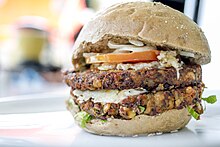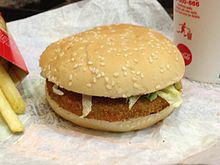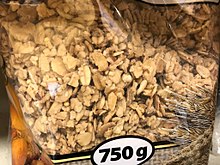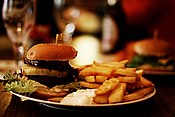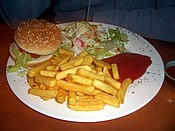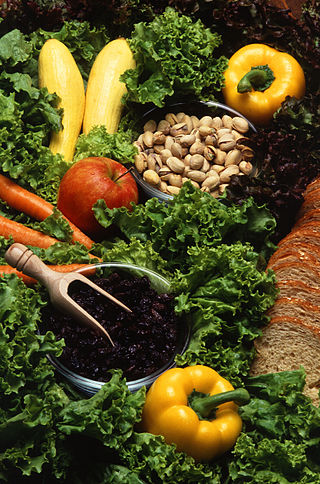
Vegetarian cuisine is based on food that meets vegetarian standards by not including meat and animal tissue products.
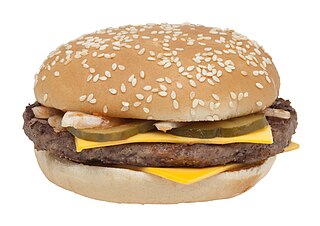
A hamburger or simply burger is a food consisting of fillings—usually a patty of ground meat, typically beef—placed inside a sliced bun or bread roll. Hamburgers are often served with cheese, lettuce, tomato, onion, pickles, bacon, or chilis; condiments such as ketchup, mustard, mayonnaise, relish, or a "special sauce", often a variation of Thousand Island dressing; and are frequently placed on sesame seed buns. A hamburger patty topped with cheese is called a cheeseburger.

Falafel is a deep-fried ball or patty-shaped fritter of Egyptian origin, featuring in Middle Eastern cuisine, particularly Levantine cuisines, and is made from broad beans, ground chickpeas, or both.

A chicken nugget is a food product consisting of a small piece of deboned chicken meat that is breaded or battered, then deep-fried or baked. Developed in the 1950s by finding a way to make a coating adhere, chicken nuggets have become a very popular fast food restaurant item, and are widely sold frozen for home use.

Korokke is a Japanese deep-fried yōshoku dish originally related to a French dish, the croquette. Korokke is made by mixing cooked chopped meat, seafood, or vegetables with mashed potato or white sauce, usually shaped like a flat patty, rolling it in wheat flour, eggs, and Japanese-style breadcrumbs, then deep-frying this until brown on the outside.
Gardenburger is the brand name of a veggie burger sold in the United States. It was developed in the early 1980s by Paul Wenner, the owner of the Gardenhouse, a vegetarian restaurant in Gresham, Oregon. It is currently owned by Kellanova.
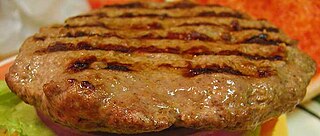
A patty or burger is a flattened, usually round, serving of ground meat or legumes, grains, vegetables, or meat alternatives. Patties are found in multiple cuisines throughout the world.

A nut roast or roasted nut loaf is a vegetarian dish consisting of nuts, grains, vegetable oils, broth or butter, and seasonings formed into a firm loaf shape or long casserole dish before roasting and often eaten as an alternative to a traditional British style roast dinner. It is popular with vegetarians at Christmas, as well as part of a traditional Sunday roast. Nut roasts are also made by Canadian and American vegetarians and vegans as the main dish for Thanksgiving or other harvest festival meals.

Gardein is a line of meat-free foods produced by Conagra Brands. In 2003, the company was founded by Yves Potvin, who remained as the CEO of Gardein until 2016. In November 2014, Pinnacle Foods purchased Gardein for $154 million. Pinnacle was acquired by Conagra in 2018.
McDonald's Corporation is the world's largest chain of fast food restaurants, serving around 68 million customers daily in 119 countries. McDonald's traces its origins to a 1940 restaurant in San Bernardino, California. After expanding within the United States, McDonald's became an international corporation in 1967, when it opened a location in Richmond, British Columbia, Canada. By the end of the 1970s, McDonald's restaurants existed in five of the Earth's seven continents; an African location came in 1992 in Casablanca, Morocco.
McVegan is a veggie burger sold by the fast-food restaurant chain McDonald's. In 2017, McDonald partnered with the Swedish food company Orkla to create a plant-based patty inside a small steel kitchen in Malmö, where they began the creation of the product. In Germany, the chain's vegan burger is sold as the Big Vegan TS.

The Impossible Whopper is a veggie burger sold by Burger King. It is a variant of the Whopper, with a burger patty made from a meat alternative provided by Impossible Foods. First introduced in the United States in 2019, it was made available in Canada in 2021.

The McVeggie is a veggie burger sold by the fast-food restaurant chain McDonald's. It was introduced in 2012 in India when McDonald's opened its first vegetarian-only restaurant in the country.

A tempeh burger is a vegetarian hamburger variant with tempeh—Indonesian fermented soybean cakes, as main ingredient.

The McPlant is a vegetarian burger sold by the fast-food chain McDonald's in several European countries. In 2021, McDonald's partnered with Beyond Meat, a Los Angeles–based producer of plant-based meat substitutes, to create the McPlant platform. It features a plant-based meat alternative burger patty made from plant ingredients such as potatoes, peas and rice.

Lord of the Fries is an Australian and New Zealand casual dining fast food chain, originally based in Melbourne, before expanding into other regions. It serves only vegan dishes including loaded fries, veggie burgers, hot dogs and a number of various sides and breakfast items. Lord of the Fries first started as a vegetarian "mobile chip van" in August 2004 which was driven across the country until late 2005 when the first store location was opened in Melbourne's city centre. Due to the menu consisting entirely of plant-based products, all meals from the chain are Kosher and Halal. The restaurants became 100% vegan in 2018. The founders are vegan as are most of the franchisees.

Corn schnitzel is an Israeli fried corn dish and variant of Israeli schnitzel that is especially popular among vegetarians, vegans, and children.
